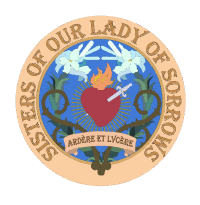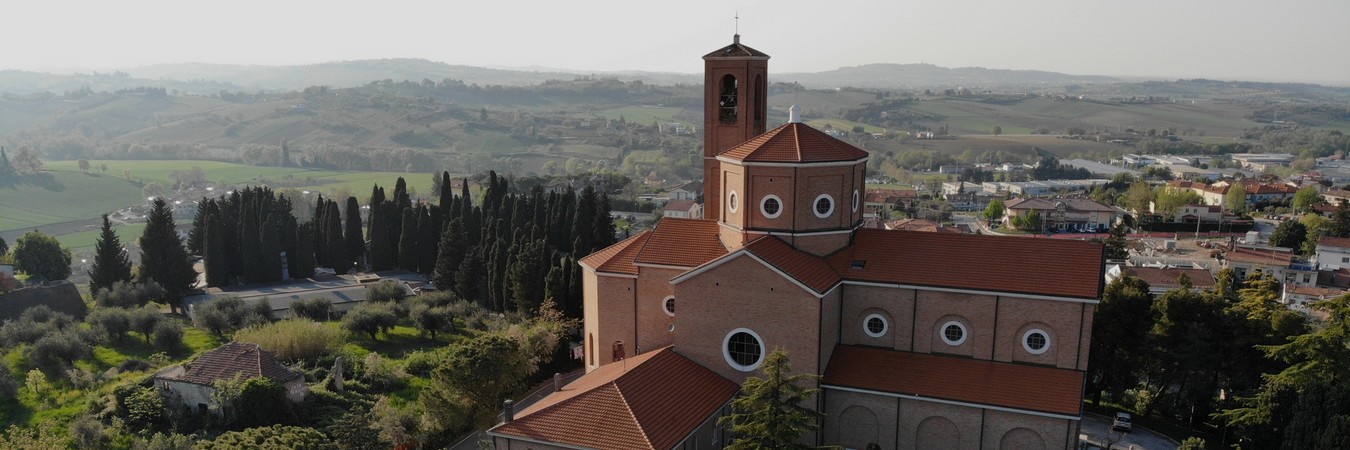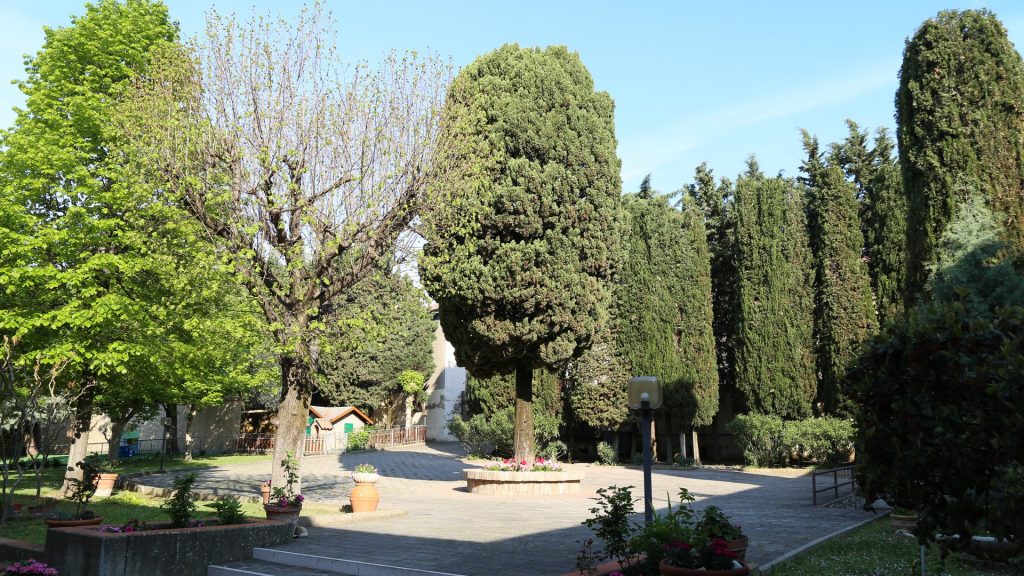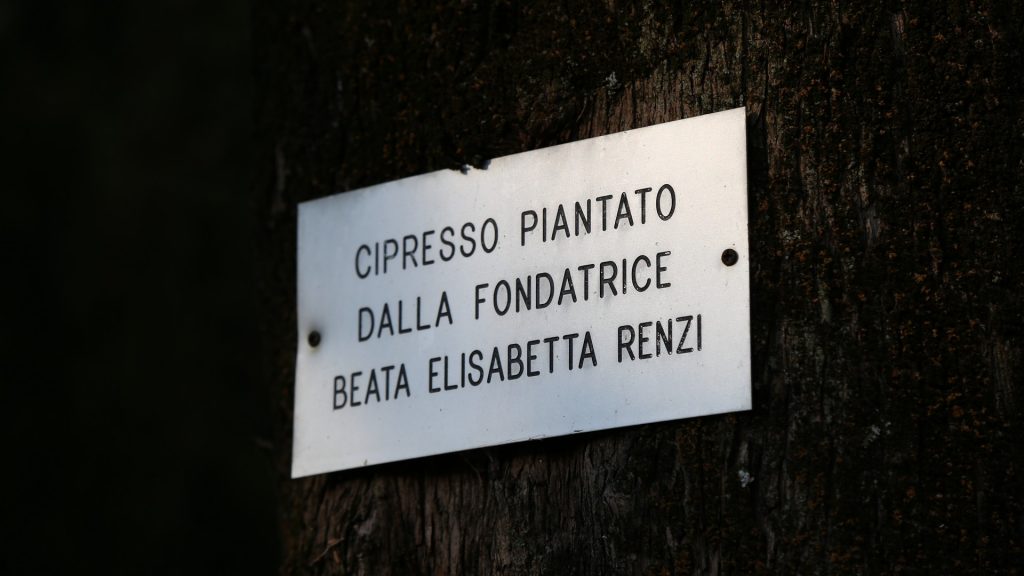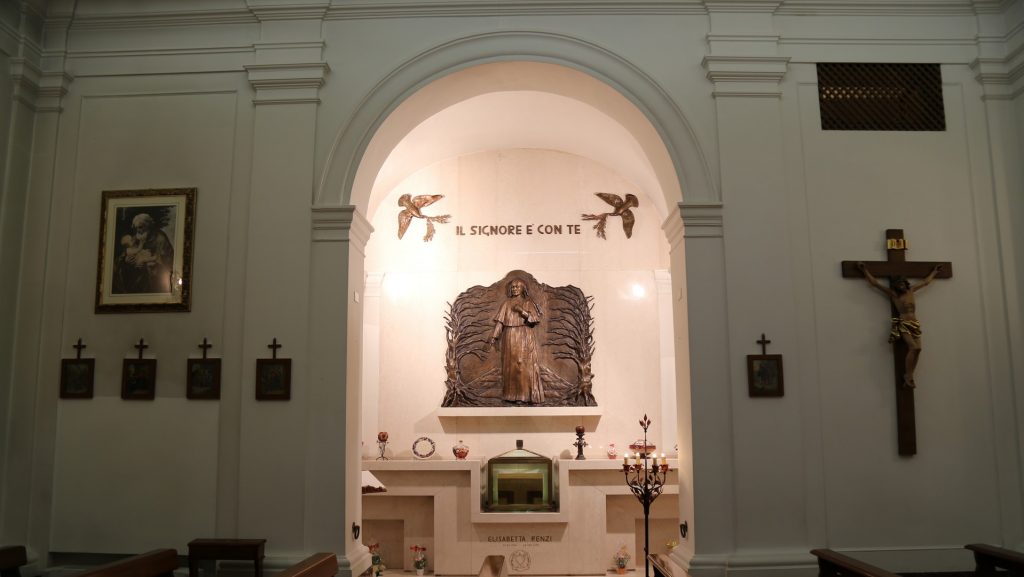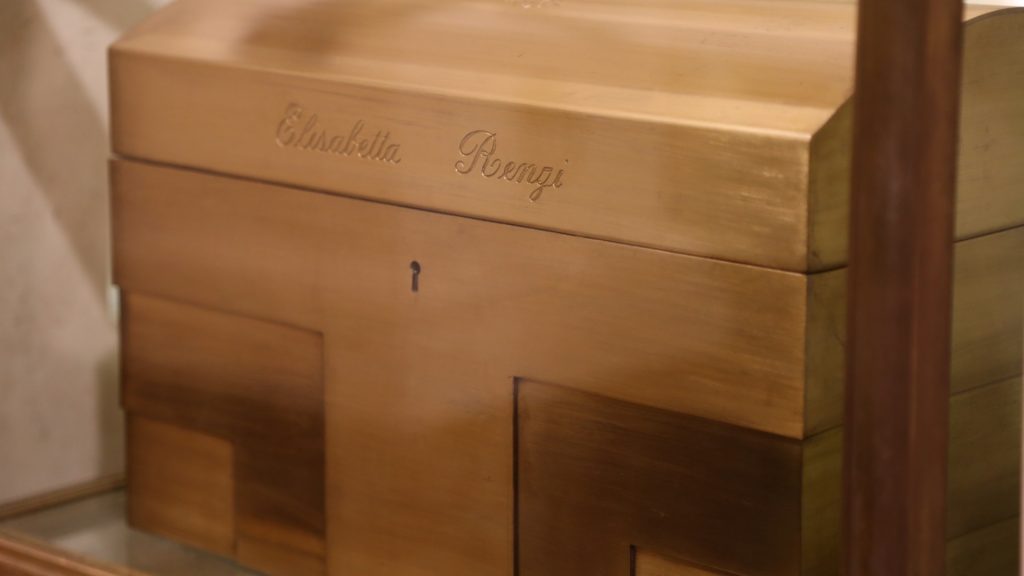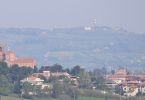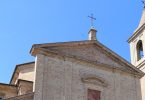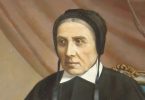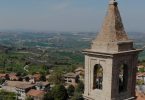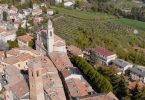from April 29, 1824 to August 14, 1859
At the age of 37, on April 29, 1824, Mother Elisabetta arrived in Coriano:
In the evening, that time of day that is so sweet and mystical, I entered in that new ark, I heard dear voices full of faith and warm with love that brought me to tears: the prayers of the little students who were studying and working, were like a delicate hymn, a pleasing incense.
The Conservatory of Coriano was founded by Fr. Giacomo Gabellini, pastor of the parish church in Monte Tauro (Rimini), a man of great zeal and sound doctrine. He was the inseparable companion of Fr. Vitale Corbucci in preaching the missions to the people. In 1818, he was commissioned by the municipality of Coriano to provide a school for the poor girls of the town.
He bought some rooms in a house owned by the parish priest of Valecchio to use for the school and entrusted its direction to Prudenza Uccellini, who had already been a teacher in Ravenna, Cesena, and Rimini, always in the praiseworthy exercise of instructing the girls. With the help of Antonia Mainardi, the school was opened on May 27, 1818.
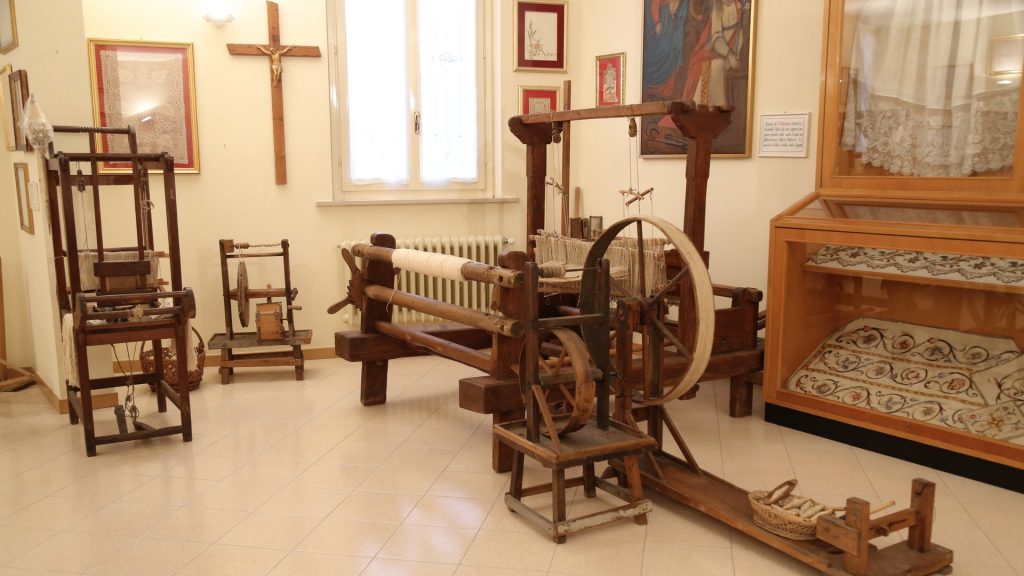
CORIANO – OBJECTS DATING BACK TO ELISABETTA RENZI TIMES 
CORIANO – OBJECTS DATING BACK TO ELISABETTA RENZI TIMES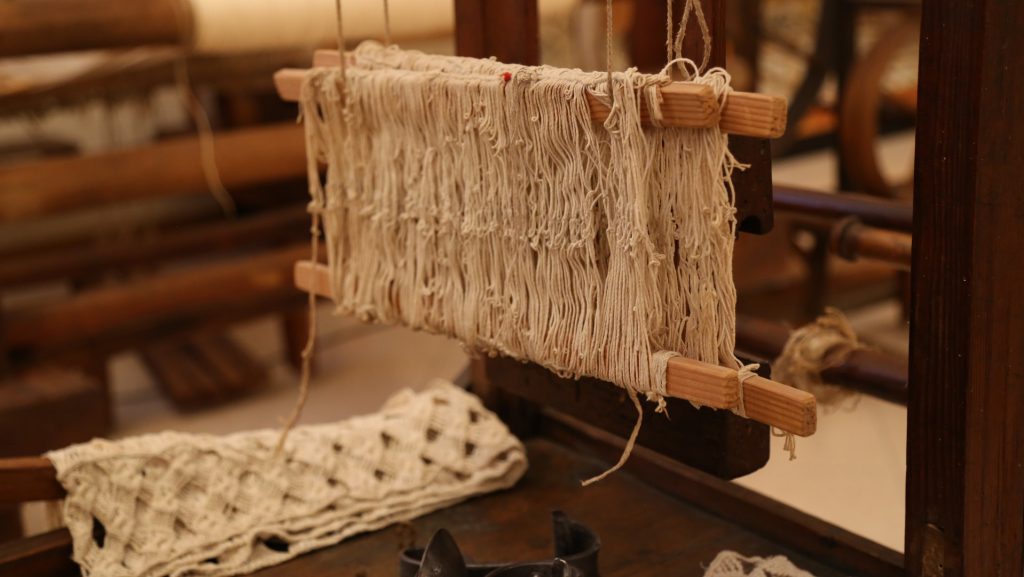
CORIANO – OBJECTS DATING BACK TO ELISABETTA RENZI TIMES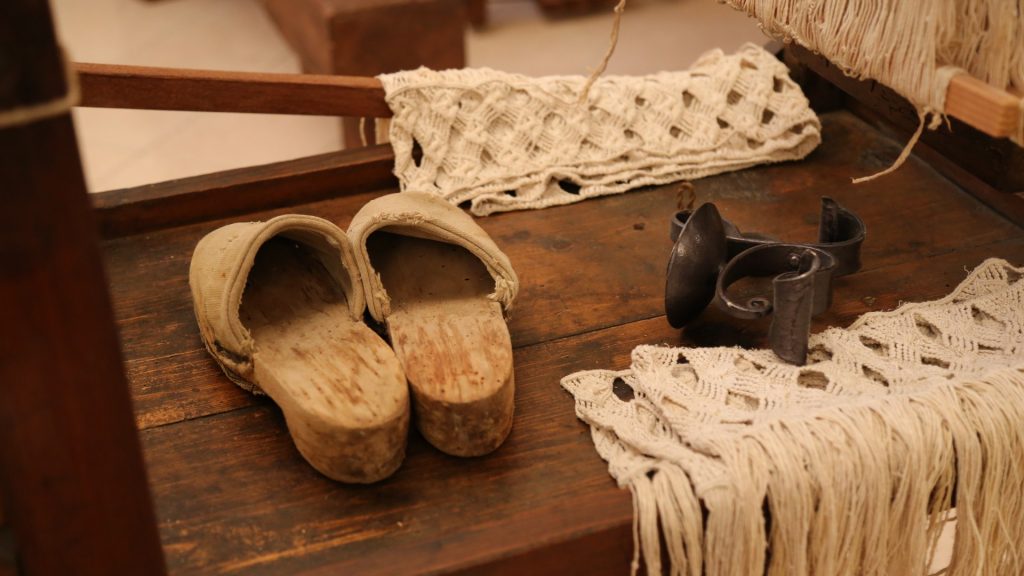
CORIANO – OBJECTS DATING BACK TO ELISABETTA RENZI TIMES
A few months after the arrival of Elisabetta, on July 16, 1824, the construction of the chapel began, which was blessed on May 31, 1825, and dedicated to Our Lady of Sorrows.
On October 15, 1825, the Bishop granted permission to keep the Blessed Sacrament in the church, and given the extreme poverty at the beginning, the sisters deprived themselves of the oil to keep the lamp of the Blessed Sacrament lit. (Origins and the Development of the Congregation of the Sisters of Our Lady of Sorrows, C.Giovannini, p.25)
From old photographs, the chapel had a large ornate frame above the main altar, with the statue of Our Lady of Sorrows at its center. That frame can no longer be found.
A few months after the chapel was built, Dr. Patrignani donated a fresco of the Blessed Virgin of Grace. The Pious Teachers wished to have it placed in a chapel with an altar and began to pray together. It just so happened that their confessor, Fr. Macchini, won some money and decided to build a side chapel at his own expense on the right side of the church.
In detaching it from the wall to relocate it, the fresco fell and broke into several pieces to the point that it could not be put back together. A testimony narrates that Mother Elisabetta “picked up the pieces in which the fresco had been broken and put them together, and no one could see where it had been broken, so that everyone cried out for a miracle.
The dear Mother nurtured a particular devotion for this image; she resorted to her in every necessity and placed the girls who went to the Conservatory under her protection” (Positio p. 602).
The people from Coriano received many graces going with faith to the Blessed Mother, and they invoke her still today under the title of “Virgin of All Graces”.
Soon an additional side chapel on the left was also built, dedicated first to Saint Philomena (the painting that was there is now in the museum) and then to the Sacred Heart.
Today, in this left chapel, there is a monument with the urn of the mortal remains of Blessed Elisabetta Renzi, dedicated to her in the year of her Beatification: June 18, 1989.
On October 28, 1896, the first exhumation of her body was performed, and the bones were placed in a zinc urn, kept in a niche on the right side of the main nave of the chapel, adorned with a statue of the bust of Elisabetta, which is now kept on the upper floor of the house in Coriano.
Behind the main altar was the nuns’ choir, from which the “little communion door” opened, visible to the right of the altar near the grate just above the altar.
High up on the left side wall of the chapel, one can also see the grille of Mother Elisabetta’s room, through which she could always see the tabernacle and pray, both day and night.

CORIANO – CHAPEL 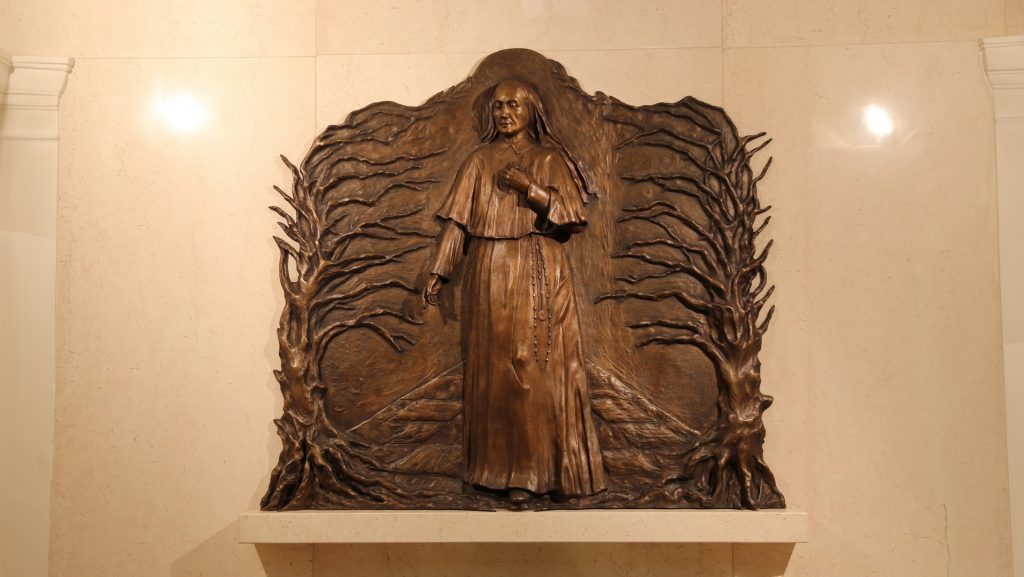
CORIANO – CHAPEL: ELISABETTA RENZI MONUMENT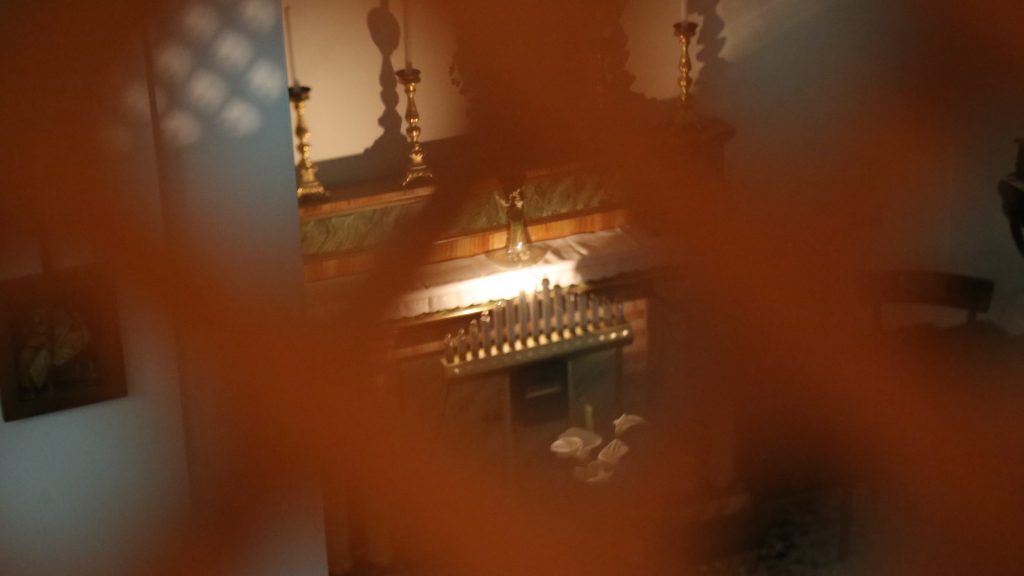
CORIANO – FROM THE CHOIR OF THE ROOM OF ELISABETTA RENZI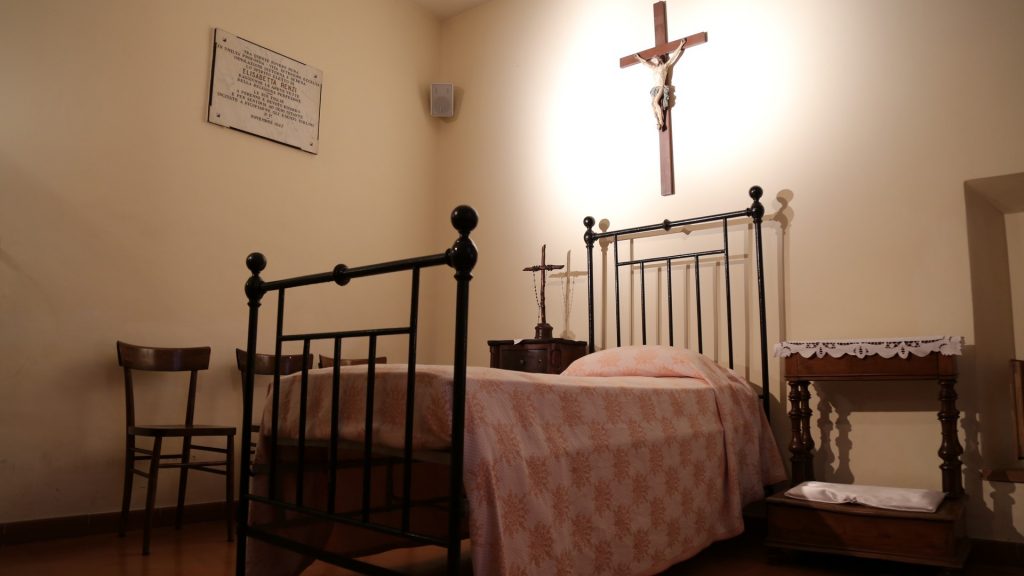
CORIANO – ELISABETTA RENZI ROOM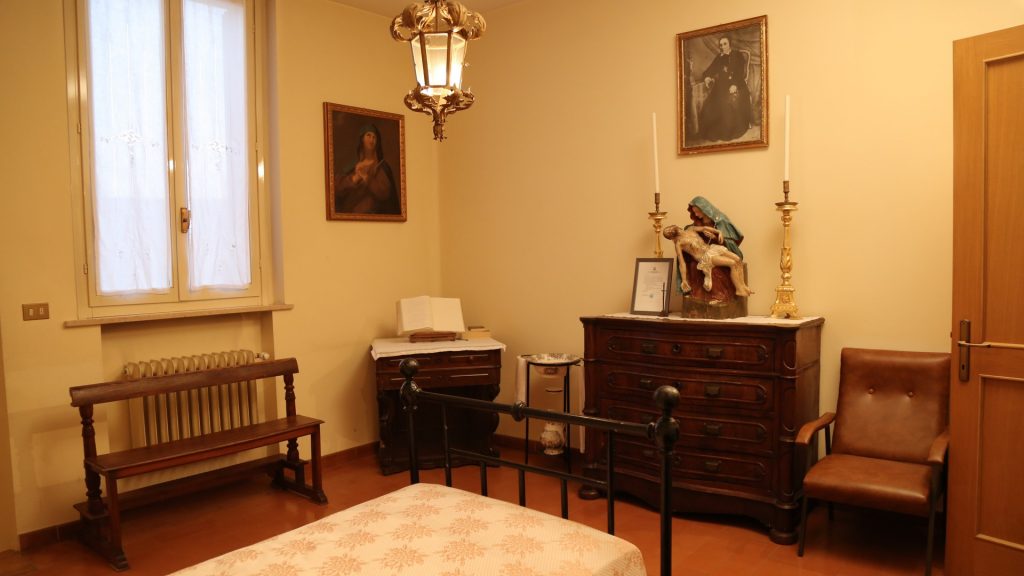
CORIANO – ELISABETTA RENZI ROOM
The building initially consisted of a single two-story, square-shaped building that faced Via Malatesta [the street]. DIFFICULT BEGINNINGS In 1825 correspondence had begun between Don Gabellini and the Marchesa Magdalena di Canossa, founder of the Daughters of Charity of Verona, in anticipation of the merger of the Conservatory with the Istituto della Marchesa. He spent a few days “to negotiate with the archpriest and the other people the foundation shop, which was already underway. She knew about the almost insurmountable difficulties “, but accepted” the party to do an experiment before abandoning the enterprise” (Positio p.83). After a visit to the Conservatory he wrote of our Blessed: During the riots of 1828 an unpredictable storm, due to unfounded slanders, struck the Conservatory: Don Gabellini and the director Fattiboni had to leave Coriano; the teachers fell into a great sorrow and believed that the house would close, so each one was thinking about how to arrange their own accommodation. Elisabetta after consulting the ecclesiastical authority, her mother and brother Giancarlo, accepted the goodness of God, took over the direction of the work, and with faith and courage, immediately took action to lift it up. The correspondence with Magdalena di Canossa continued until 1835, the year of her death. Contacts with the Canossian Institute continued until 1837, the year in which they stopped without Elisabetta and her companions succeeded in joining it. The problems for the Conservatory continued. In 1831, during the revolutionary movements of Romagna, their spiritual director Don Francesco Macchini was imprisoned for some time. Liberals continued to persecute him together with the Conservatory, and on July 14, 1832, anonymous men posted infamous pamphlets on the walls of Coriano. The municipality took up their defenses and instituted a trial to identify the culprits (Positio p. 108). In 1833 Don Gabellini from Florence wrote to Elisabetta that he would have decided to sell the house of the Conservatory. “And she wanted to buy it by taking on all the debts of which she was aggravated, and from which she soon released it, starting with the most serious” (Origin and development of the Sisters of Our Lady of Sorrows, pp. 41-42) using most of her assets. Following these tests, Elisabetta understood that it was necessary to create an atmosphere of trust and encourage an intense commitment to spiritual life. For this reason, since February 1829, he drafted a regulation entitled theRegules of life prescribed to the Poor of the Crucified withdrawn in Coriano. Following these tests, Elisabetta understood that it was necessary to create an atmosphere of trust and encourage an intense commitment to spiritual life. For this reason, since February 1829, he drafted a regulation entitled the Regulations of life which is prescribed to the Poor of the Crucifix withdrawn in Coriano. Here he recalls the need for detachment from the world to live the spirit of the cross, indispensable for “having the most loving conversation with the divine Bridegroom and hearing his loving voice in solitude and in the recollection of spirit”. “It would be useless, and diabolical, and pernicious deception, the desire, and the willingness to be among the poor of the Crucified One, when there was no greater desire to lead a truly holy life, with the fervent commitment to walk happily along the way only of the precepts, but also of the advice of Jesus Christ.
It was gradually enlarged to be able to accommodate the girls and the day school children, in addition to Mother Elisabetta and her companions (who in 1825 numbered about twenty), as well as the school for weaving (with looms) “where one learns to weave all kinds of works” and the places necessary for a common life.
The building was almost completely destroyed during the Second World War and was rebuilt as we see it today.
From testimonies, we know that the entrance facing the Via Malatesta was in the same position and had more or less the same appearance as it is today. Behind the house, there was a garden with rows of vines and olive trees, and a well for washing clothes.
In the center of the courtyard stands a cypress tree, which is said to have been planted by Mother Elisabetta herself.
Magdalena went to Coriano on September 30, 1826 and thus expresses herself: “I found a community of Angels. With a lot of internal spirit and that I am of such composure and recollection in the church that I need confusion and edification “…” There I found twelve daughters gathered in that small convent of singular piety, and all heaven ”. (Positio p. 43)
“Between the Lord and Elisabetta, there is such an outpouring of mutual love, such a perfect reciprocal donation, to be sure that in setting foot in Coriano the knot that keeps in the sky was tightened between the creature and the Creator”
(Positio p.541).
The slander of the accusers was also opposed by the mayor of Coriano who, worried about the fate of the conservatory, wrote a letter to the Bishop on 10 June 1828 to prevent its closure.
On June 21, 1828 Elisabetta pointed out to Magdalena the sad situation of the community. In September she went to visit Coriano again and on this occasion advised Elisabetta to take the direction“by sacrificing for divine glory, at least for then, to the desire she had to embrace the Institute, since without her she could not have to exist” (Positio p. 87).
So he wrote:
“We have a sad present …
and why won’t we hope for a better tomorrow?
The great battles have always been won on one’s knees
before God: let us pray!” (Positio p.541).
(…) The only name of the poor of the Crucifix withdrawn from the world makes one conceive the right idea of what this house must be; that is, a union of fervent souls, detached from the world, affectionate only to Jesus Crucified, and imitating him as much as they can in poverty, mortification and charity, they only try to make the most loving conversation with the divine Bridegroom, and to feel loving his voice in solitude, and in the recollection of spirit, where he promised to lead his brides, to speak to their hearts. Ducam eam in solitudinem, et loquar ad cor eius (Hos 2,14: Therefore, behold, I will draw her to me, I will lead her to the desert and speak to her heart).
[…]
Anyone therefore who wants to set foot in this retreat to be poor of the Crucified One, and to enjoy his loving conversation, it is necessary that he imprints in his mind three maxims, and that he calls to examination his strengths to know if with the help of God he she will feel capable of putting them into practice: which is the same as saying, if her will is resolute to practice them, and we will say even better if God calls her to this standard of living. The first maxim is this, that one must have died in the world; the second that one must have died to herself; the third finally, that we must live only to Jesus Crucified.”.
CANONICAL ERECTION AND FIRST PROFESSION
From 1836 to 1839, there were other attempts to join the “Maestre Pie” of Rome, following the suggestions of Monsignor Gentilini, Bishop of Rimini, through Fr. Benedetto Corbucci, brother of Fr. Vitale, and through Elisabetta herself, specifically to the “Maestre Pie Venerini” of Rome. These attempts failed. On February 2, 1838 he wrote again: Most Reverend Excellence The testimony of the Mother’s profound spirit of faith and humility shines especially in the years 1838 – 1839 when the date of the canonical erection and dressing of the new Religious Family was postponed for several times. Her brother Giancarlo writes to his sister, expressing a certain grievance for his choice to give the premises of the Conservatory to the Bishop, inviting her instead to take part in it for herself. On August 22, 1839 Elisabetta signed the deed of sale of the Conservatory’s premises in favor of Mons.Gentilini. They are: Mainardi Mariantonia, Venerucci Maria, Onofri Teresa, Beccari Rosa, Ferri Maria Domenica, Brunetti Amasia, Brunetti Regina, Sabattini Rosa, Manzi Benedetta, Sambi Lucrezia. “How good is the Lord! I can’t find words to express my happiness in religion. Every day I appreciate more, here there is only Him. He is everything and everything and everything is enough.” On August 14, 1859, at around 8 am, Elisabetta died in Coriano at the age of almost 73 years. On August 14, 1859, at about 8:30 a.m., Elisabetta died in Coriano at the age of almost 73.
Elisabetta often wrote to the bishop to speak to him about the community’s lifestyle, about her worries, and to ask for counsel or clarifications on what to do and how to continue in her endeavor. She ardently desired to wear the religious habit and embark on a new journey toward holiness by ministering to others through education and catechesis.
Most Reverend Excellence
Here we live with the utmost parsimony, contenting ourselves with a pound of meat or fish for fifteen people. However, I suffer the bitter tribulation of seeing needs and not finding remedies. But all of us, who in one way, who in another, feel the weight of our crosses, and we all equally need to seek comfort in Crucem Domini Iesu Christi, in quo est salus, vita et resurrectio nostra (in the Cross of the Lord Jesus Christ, in whom is our health, life and resurrection – Gal 6,14).
The Alleluia stays at home beyond the ordeal! I thank the Lord for having elected me to this life.
[…] It also seems necessary to complain that it is not the interest that drives me to desire these means, and not to neglect those few diligences that are in my hands; but only the desire that the Lord remain more honored by means of the education of the girls, and to correspond to that vocation that the Lord has given me, and that it seems to me now to see fulfilled by it the internal promises which he woke in me, which would have provided me the means to fulfill those desires that he himself suggested to my heart, as they always have been, that there were schools in all countries.
Oh how well it must redundant for its diocese!
Oh how much need there is of education in the countries, there is so much ignorance in the things of faith! I am only scared of my insufficiency, but the Lord will know how to provide for everything.
Most Reverend Excellence
Last Thursday I received the most venerated letter that Your Excellency addressed to me, read for the first time on the flight, so I went to consider it at the foot of the Crucifix not only, but also before the Blessed Sacrament for good consideration, and also to receive some comfort from that displeasure, which caused me the same in knowing that, after having already made public the function that was to be done, already announced by the parish priest at the altar, and for the invitation made to all the parish priests of this vicariate , and to the matrons who were to accompany us, and the magistrate, the girls, Your Excellency would not want to complete so many projects.
. I was truly surprised, and all the more sorry because it seems, from the aforementioned letter, that this is my fault, and that I am dominated by a spirit of pride and insubordination. It can be unfortunately, since self-love can make me see, and if to mortify this spirit of pride in my superior, that this humiliation was necessary for me, I would bless, even in the midst of tears, the dispositions of the Lord manifested to me through it.
I could say something in my defense, but I don’t want to do it, if my superior doesn’t tell me if it is good or not that I do it. Finally, I pray the goodness of Your Excellency to be able to tell me how to regulate myself below … (Positio pp.182-183)
Dear brother, let’s not look too much ourselves. We would like to see, understand … and we do not have enough trust in the One who fills us and surrounds us with his charity. We gather all the lights of faith to rise higher, higher. At the instant of death, as at the extreme frontier that separates us from other life, we will see and understand the great reality of things»
(Positio pp.184-185)
On August 26, the Bishop consented to the canonical erection of the Institute and on August 29, Elisabetta and ten companions could wear the dress of the Sisters of Our Lady of Sorrows in the parish church of Coriano.DEATH OF ELISABETTA
The funeral was a song of praise. Her body, the holy ark from which her soul had departed, remained in that place where she had consummated her sacrificial life and was humbly buried in the church of the Conservatory in Coriano… (Positio pp.525-527)
“Jesus is here … and He is always with you …. He alone has founded the Congregation; He alone will keep watch over it. I didn’t do anything! … I have done nothing but undo His work …. Let us love our good God! … I in the blessedness that I hope to reach through his goodness and mercy, you in humility and struggle.”
“Oh! How beautiful is the angel of death! The angel of death who leads men into heaven is their best friend!”
“I ask pardon of everyone for all my faults and omissions. Pray for me! Goodbye, beloved daughters; be generous with the Lord. I carry you all in my heart and bless you …. We will see each other up there in heaven … up there …. And from up there I will tell you again to be grateful to the Lord. Let your faithfulness be your thanksgiving, since the more you receive, the more God will ask of you, my daughters ….”
At eight o’clock in the morning, Mother Elisabetta lay dying in a state of complete abandonment to her Crucified Spouse. Then she suddenly whispered: “I see! … I see! … I see!”. And whatever was left of mortal life was gently lost in eternal life. She died like the saint that she was, and her daughters learned how to die well from the one who had taught them how to live well. Her beautiful soul will surely meet the blessed spirits of her dear daughters who preceded her. She will surely kiss the hand of the Queen of Heaven, who called her to paradise on the vigil of her glorious Assumption into heaven. The Bishop of Rimini wrote to her grieving sisters: “Her beautiful soul flew among the angels to make paradise more joyful”.
